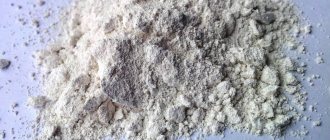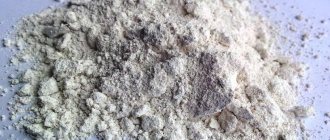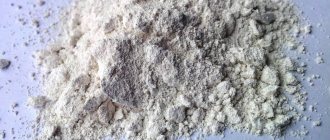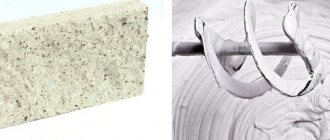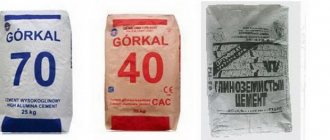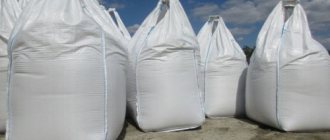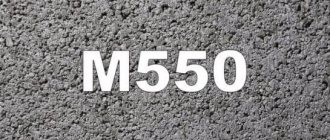Universal white cement is a material that is used in the production of paving and finishing slabs, restoration and other work in the construction industry, and the casting of various statues. The method of its manufacture, as well as the starting raw materials, differ from the standard ones, which has a beneficial effect on the properties of the substance and the curing time of the products. You can start molding blanks 48 hours after pouring.
White cement, compared to its traditional counterpart, has a number of advantages: both operational characteristics and its aesthetic properties.
White as snow, strong as stone
The basis of the substance is low-iron clinker, with which kaolin, chloric salt, gypsum, and crushed limestone (chalk) are mixed in the required ratio and order. The components include the smallest amount of manganese or coloring inclusions. The specific color is provided by the combination of kaolin and limestone.
A special manufacturing method gives the substance not only color, but also increased strength (up to 59 MPa). Depending on its indicators, 3 types of cement are distinguished, each of which demonstrates good weather resistance and resistance to low temperatures and the negative effects of precipitation:
- M400 has an average hardening speed, low sulfate resistance, medium and high shrinkage deformation.
- M500 exhibits medium hardening rates, average sulfate resistance and low shrinkage deformation.
- M600 means insignificant deformation during shrinkage, low sulfate resistance, high hardening speed.
According to the degree of color purity, the material is divided into 3 grades: highest grade - from 80 to 85%, 2nd grade - 75%, 3rd grade - 68%.
A distinctive property of the powder substance is its high degree of grinding. It is about 4500 sq.cm/g. For gray analogs, the indicator is 3500 sq.cm/g.
These characteristics determine the price, application options and appearance of the products. All parameters are indicated on their packaging.
Since the material is considered a new product, imported dry granules prevail among the products presented on the construction market, in particular products of the Swiss financial and industrial group Holcim.
Types and classification
The classification of white cement is determined by its strength. The most common grades of cement are M 400, 500, 600.
- M400 - has an average shrinkage percentage and an average hardening speed. Brand of high strength and frost resistance.
- M500 has a low percentage of shrinkage and deformation compared to M400, and the same hardening time. Durable, waterproof and frost-resistant.
- M600 – fast hardening time and almost complete absence of shrinkage. Resistant to moisture, frost and fire.
The labeling may contain a D0 value, which means the composition contains no additives.
White cement is divided according to the level of whiteness reflection (reflection coefficient), which affects the decorative effect of products made from this material. The higher the grade, the more snow-white the finished product from this material will be.
- 1st grade – at least 80% whiteness;
- 2nd grade – at least 75% whiteness;
- 3rd grade – at least 68% whiteness.
There is also “Premium” - this is when the material contains more than 90% whiteness. This is a rare variety that is not produced by all manufacturers.
Features of white cement production
The mixing of raw materials is carried out carefully and carefully. Upon contact with certain substances, it is capable of changing properties. Violating the technology and using the wrong tools can lead to streaks or poor color quality.
In order to prevent the possibility of defects, clean working containers and substances are used. In some cases, equipment and surfaces in contact with the material are degreased. Metal parts are treated with anti-corrosion compounds and then covered with a layer of concrete. Compliance with all conditions allows us to maintain the purity of raw materials.
Grinding is carried out in mills equipped with plates made of porcelain, silicon and basalt. After some time, the resulting mixture is sent to special firing chambers. According to the technology, they use gas or liquid fuel burners that do not form soot and ash residues.
The light shade of white cement is obtained due to the composition and special technology of its production.
After calcination to 1200...1400°C, the clinker is subjected to rapid cooling in an oxygen-free environment (1200...200°C). This hardening enhances the strength and frost resistance of cement.
To achieve pure whiteness, use the method of rapid cooling with water (1500...500°C). Then the mass is dried in a special drum at a temperature of 300°C. This is how a brand with a degree of reflection of up to 90% is obtained.
Production technology
Clinker for the production of white cement is obtained from raw materials with a minimum content of “coloring” substances - oxides of Fe, Cr and Mn. The main components of clinker are: kaolin, white limestone and marble.
The technology for the production of white binder is practically no different from the technology for the production of conventional “gray” cement. However, due to the fact that there are a number of features, it is somewhat complex and consists of the following stages:
- Enrichment of raw materials by sequential crushing and processing in screens using dry or wet technology. During this operation, unwanted “coloring” impurities that have accidentally entered are removed from the raw material.
- Roasting of raw materials in rotary kilns running on natural gas or fuel oil (ash-free coolants). Due to the virtually zero presence of iron oxide, the liquid phase of white cement clinker forms at higher temperatures than the liquid phase of conventional binder clinker and is characterized by increased viscosity and a small temperature differential between melting and hardening. Therefore, raw materials for white cement are fired at a temperature of 1620-1650 degrees Celsius.
- Clinker bleaching. The technical meaning of the operation is to restore the iron oxide (Fe2 O3) present in the finished clinker, which gives the material a greenish tint, to (Fe3 O4), which has little coloring ability.
All other stages: clinker grinding, laboratory tests and packaging of finished cement are similar to the production technology of conventional cement.
Areas of use
- Production of reinforced concrete forms and structures. The dry binder is used in the production of staircases and decorative interior elements.
- Preparation of mixtures for self-leveling floors. When forming a concrete mass, fillers are added: purified quartz or washed river sand, marble flour. This type of concrete differs from standard concrete in the absence of coarse crushed stone and, accordingly, in high shrinkage.
- Production of facing bricks.
- Production of paving slabs and curbs. They can be either completely white or painted with special dyes.
- Formation of mixtures for masonry mortars and joint grouts. As a filler, gypsum or crushed chalk is added to the composition of the latter. The hardening speed depends on this.
The scope of application of cement also includes the creation of cast sculptures for outdoor use. Such objects can last at least 10 years.
Cement WHITE M 600 D-0 Türkiye super white Adana bag 50 kg
Promotion details:
- – from the 28th to the 2nd of each month
- – the promotion applies to all products
- – order amount from 50,000 rubles
- – delivery within Moscow within the Moscow Ring Road or delivery outside the Moscow Ring Road*
- *When delivering outside the Moscow Ring Road, only mileage is paid.
* The order must consist of products listed in the above sections.
We offer white cement M 600 made in Turkey. The material is manufactured using special technology, which minimizes the iron content. This feature gives the cement a super white color, comparable in degree of whiteness (90%) only to titanium dioxide.
Characteristics
Fully hardened cement mortar:
- Resistant to humidity and sudden changes.
- Characterized by high final strength. Cement M 600, in contrast to its analogue M 500, has increased corrosion resistance and strength properties. As a result, its use in construction and repair ensures the durability of constructed objects, structures and individual elements.
- Resistance to temperature influences, seasonal thawing/freezing cycles.
During operation, structures or individual elements made of Adana cement do not lose their original white color, even under conditions of negative atmospheric influences, dampness, and ultraviolet radiation.
Application area
White cement M 600 is used in construction and repairs. It is used for the production of individual reinforced concrete products (beams, slabs, blocks, etc.), as a binder for finishing plasters, putties, leveling mixtures, and grouts. In landscape design, small architectural structures and sculptures are made from cement mortar. Adana can also be used independently, as an installation (installation of windows, sockets, etc.), restoration and adhesive material.
Table for calculating the cost of delivery of orders:
For orders up to 100 kg we offer a budget delivery cost (delivery time up to 2 days):
| Delivery area | in Moscow | Moscow region from MKAD (up to 15 km)** |
| Load weight up to 10 kg | 290 rub. | 490 rub. |
| Load weight up to 15 kg | 350 rub. | 590 rub. |
| Load weight up to 20 kg | 450 rub. | 690 rub. |
| Load weight up to 50 kg | 550 rub. | 790 rub. |
| Load weight up to 100 kg | 650 rub. | 990 rub. |
* Drywall, insulation, lumber, profiles for gypsum boards, foam blocks and bricks are calculated from the table from 100 kg.
**Delivery over 15 km, calculation is based on the “tariff” + 50 rubles per 1 km.
For orders of 100 kg or more:
| Delivery area | Moscow inside the Third Transport Ring*** | Moscow inside the Moscow Ring Road | Moscow region from MKAD |
| Cargo weight up to 400 kg * | 800 rub. | 800 rub. | 800 rub. + 25 rub. per km |
| Cargo weight up to 1 ton** | 1,450 rub. | 1,450 rub. | 1,450 rub. + 25 rub. per km |
| Cargo weight up to 2 tons** | 1,950 rub. | 1750 rub. | 1,750 rub. + 25 rub. per km |
| Cargo weight up to 3 tons** | RUB 2,950 | RUB 2,850 | RUB 2,850 + 25 rub. per km |
| Cargo weight up to 4.5 tons** | 4,150 rub. | RUB 3,950 | RUB 3,950 + 60 rub. per km |
| Cargo weight up to 6 tons** | RUB 5,850 | RUB 5,550 | RUB 5,550 + 60 rub. per km |
| Cargo weight up to 10 tons** | 10,000 rub. | 8,000 rub. | 8,000 rub. + 60 rub. per km |
* provided that the ordered product fits into a passenger car.
** provided that the volume of the ordered goods fits into a truck of the specified tonnage.
Delivery of unsawn 6 meter lumber (boards, timber) with a volume of up to 2 m3 costs from 3,000 rubles.
When paying for delivery by bank transfer, 5% is added to the delivery cost.
Additional requirements for the car, for example, a small height for entering a parking lot or an open body for vertical unloading, are paid additionally: +20% of the cost of the standard tariff.
Cost of unloading and lifting
Table for calculating the cost of unloading orders:
| Unloading | Up to 400 kg | From 400 kg to 3 tons |
| Unloading and lifting into the apartment | 500 rub. | 800 rub. (per 1 ton) |
| Unloading without climbing to the floor | 500 rub. | 500 rub. (per 1 ton) |
* Prices in the table are based on a working freight elevator, regardless of the floor.
** In the absence of a freight elevator, the cost of the lift is multiplied by the number of floors to the apartment where the goods need to be unloaded.
*** The minimum order cost for unloading and lifting is 500 rubles.
Pros and cons, consumer reviews
The main disadvantage of the material is its high price. However, it pays off in the effect produced by the finished work. The use of cement allows you to speed up the finishing process and create original decorative structures.
The advantages include the following qualities of the material:
- moisture resistance;
- strength and wear resistance;
- plastic;
- rapid hardening;
- environmental friendliness;
- multifunctionality;
- uniformity;
- the ability to obtain any color by adding colored pigments.
Igor, 39 years old, Moscow:
“When building the cottage, we decided to make balcony supports in the form of patterned columns. For this purpose we used white Swiss cement. The pouring went well, the formwork was removed after 5 days. Today the coating looks great, there are no tears or other flaws. We have already used the brand for decorative work several times.”
Andrey, 28 years old, Novosibirsk:
“I used white cement in the manufacture of 3D gypsum panels, adding 15% of the substance to G5 gypsum. The durability of the products and whiteness were excellent. The advantages include convenient packaging and quality. True, the price is too high.”
Sergey, 45 years old, Voronezh:
“I was pouring the foundation for a garage in the heat. The store manager recommended a variety of Portland cement called Holcim NormoCem. He said it would be suitable because the powder is resistant to high temperatures. The mixture turned out to be soft and mobile, drying slowly. This allowed me to take my time with installation. The disadvantage is the poor packaging - it was fragile and tore at every opportunity.”
Vadim, 35 years old, Moscow:
“The location for the log house was chosen on a high slope, so a reliable and durable foundation was required. The designer proposed his own version of white cement. The result was the absence of cracks, the solution fit tightly into the formwork. I think the cost is justified."
Mikhail, 35 years old, Volgograd:
“It was necessary to plaster the cast floors. They were even, but too smooth. The customer wished that the work be carried out using M500 ExtraCem cement from Holcim. The solution turned out to be elastic, had good adhesion, and set quickly.”
Features and Benefits
- Frost resistance . Withstands more than 100 winter-summer season changes.
- High moisture resistance allows the use of white cement in any climatic conditions.
- Durability . The mixture hardens 60-65% within 15-16 hours. Complete consolidation of the material occurs within 3 days.
- Resistance to ultraviolet rays ensures pristine aesthetics for a long time.
- Decorative properties . Using coloring pigments, white cement can be converted into colored cement. This creates a wide range of ideas for architects and sculptors, practically without limiting their creative potential.
- Resistance to precipitation . Under the influence of wind, rain, snow, hail, it does not change its strength and color.
- Great dispersion . It is not destroyed by high humidity and aggressive solutions.
- Environmental friendliness . Natural ingredients are used to create white cement.
- Economical . Due to rapid hardening and high strength, the cost of working with the material is reduced. In addition, cracks hardly form, so you rarely have to spend money on repairing them.
Colored decorative cements: characteristics, composition, features
Colored construction powder is obtained by grinding together gypsum, clinker and light-resistant pigments with the addition of special additives. In industrial production conditions, products are produced in yellow, green and black colors. For this purpose, carbon black, chromium oxide and ocher are used.
During production, colored decorative cements acquire the same composition and characteristics as their white counterpart.
Colored cement, as well as white, is most often used for the manufacture of concrete products with the texture of the required color.
To obtain other colors, pigments are used, which can also be used at home. For example, eskolaite gives surfaces a pistachio tint, manganese creates colors from blue to black, and cobalt creates brown.
During the technological process, colored decorative cements acquire the same characteristics, composition and features as their white counterpart.
Manufacturers
On the construction market you can find white cement from various manufacturers - Iranian, Egyptian, Danish and, of course, Turkish. The cheapest product is from Iran, but cheap does not mean high quality. It is worth familiarizing yourself in more detail with well-known manufacturers who are famous in many countries around the world.
Aalborg White
The Danish cement plant Aalborg White has gained popularity due to the use of clean raw materials and improved production technologies
The brand's products can be found in 80 countries around the world, because they attract attention with their excellent whiteness and increased durability. Today the company's factories are located in Malaysia, China, Denmark and Egypt.
But besides the advantages, the products have one significant drawback - high cost.
White cement brand M700 from Aalborg White has the following technical characteristics:
- the degree of whiteness is 85–90%;
- belongs to the first grade;
- sold in paper bags of 25 kg;
- the price for one bag is 300 rubles;
- setting of the solution begins after 85 minutes and ends after 2 hours;
- strength of 36–44 MPa is achieved on the second day, and 68–78 MPa on the 28th day;
- expansion – up to 2 mm.
Cimsa
This company is a very famous manufacturer of building materials not only in Turkey, but also in other countries. In addition to decorative white cement, it produces decorative plasters, various putties and grouts.
Turkey is the birthplace of white cement, and the company's products fully confirm this by creating a durable and sought-after product. High quality at an affordable price is the main advantage of Cimsa products.
White cement brand M600 from Cimsa has the following technical characteristics:
- the degree of whiteness ranges from 92 to 97%;
- compressive strength after 3 days – 37.0 MPa, after 7 days – 49.1 MPa and after 28 days – 60.7 MPa;
- shrinkage is only 0.01%;
- the beginning of setting occurs after 100 minutes, and the end - 130 minutes;
- density is 3060 kg/m³.
Adana
Another popular Turkish manufacturer is Adana. It ranks second in the market after Cimsa and is a well-known exporter of construction products, including white cement.
A striking example is super white cement CEM I 52.5R. It is characterized by increased weather resistance, inertness to pigments and can be used for various purposes due to its strength and reliability.
The technical characteristics of white cement CEM I 52.5R are as follows:
- strength class – M600;
- light reflectance – 90.13%;
- setting of the solution begins after 140 minutes and ends in 190 minutes;
- compressive strength after 2 days – 38.3 MPa, after 28 days – 61 MPa.
Subtleties of manufacturing
If the need arises, such material can be made independently by diluting the mixture with water with a neutral acid-base balance after thoroughly mixing the substrate. It is important to maintain a dry powder to liquid ratio of 0.4:1 or 0.45:1.
The quality of pigments must meet basic requirements - immunity to alkali, light fastness, wettability. The degree of compatibility of the pigment with other components of the concrete mixture depends on this. The maximum density of the substance in it cannot be more than 5%.
When mixing, do not increase the content of pure white sand. It dulls the color and reduces the plasticity of the raw material. These manufacturing subtleties will allow you to obtain aesthetically attractive products of good quality.
How to choose quality cement
- Composition of cement
. The basis of the cement composition is crushed inorganic substances, for example, limestone, clay, mineral additives and fillers. Depending on the recipe, there are many types of material. The most popular in our country is Portland cement. It is suitable for the construction and production of reinforced concrete structures. But sea water destroys concrete based on Portland cement. - Durability
. The most important characteristic of any cement is strength. This indicator is included in the labeling of the material. M400 cement can withstand pressure of 32.5 MPa, this number is called the strength class. The 500th grade must correspond to strength class 42.5. Military cement (M600) has the highest strength. It can withstand a load of 52.5 MPa. The most commonly used cement brands in everyday life are M400 and M500. - Purity
. Another designation worries potential buyers. On the packaging, the manufacturer indicates a number next to the letter D. It indicates the content of additives. For example, the D20 cement mixture contains up to 20% fillers, plasticizers and other compounds. The D0 marking indicates the purity of the cement; it contains no additives. - Curing speed
. Depending on the type of work performed, the concrete solution should harden faster or slower. Therefore, manufacturers offer cement modifications with different hardening rates. If the package is marked CEM I, then the concrete will harden as quickly as possible. For M400 building concrete, the CEM V marking is considered normal. - Packing
. To package bulk and hygroscopic material, manufacturers use multilayer paper bags and sacks. Large packaging (50 kg) is optimal for construction. And when small amounts of work are performed, it is more profitable to take packages weighing 5-30 kg. - Best before date
. A distinctive feature of cement is its limited shelf life. The date of manufacture is indicated on the package, so when purchasing, you should calculate whether the composition will be used before the expiration date. Most often, the manufacturer guarantees the safety of the product from 3 to 6 months, and the time of transportation and storage in warehouses should be taken into account. Experts recommend checking the freshness of the composition yourself by hitting the corner of the bag with your hand. It is in these places that the cement begins to harden.
We have selected 11 of the best cement compositions for our review. The distribution of places in the ranking was influenced by the opinion of the expert community and reviews of Russian consumers.
This is interesting: Ceiling made of plastic panels - advantages and disadvantages
Adviсe
To perform high-quality work using white material, experienced builders advise taking into account some features:
- To obtain a high-quality solution, it is necessary to use only marble chips and sand with a low percentage of iron content, as well as clean water without heavy salts and impurities.
- After 20 hours, 70% hardening occurs, which will significantly reduce the time spent on repairs.
- Versatility, color fastness and aesthetic whiteness allow the material to be harmoniously combined with other decorative elements of the interior.
- Strength and resistance to chips and cracks will reduce additional costs for repairs and restoration of the structure.
- Tools used for finishing work must be kept perfectly clean, all surfaces must be cleaned of corrosion and contamination.
- Deepening the reinforcement into a reinforced concrete structure to a depth of at least 3 cm will avoid corrosion of metal surfaces and the appearance of stains on the white coating.
It is mandatory to apply gray cement with a thickness of at least 30 mm to the iron structure. Plasticizers, retarders and additional additives that do not affect the color of the solution can be used during the production process. To increase the percentage of whiteness, titanium white can be used. The solution must be diluted with extreme caution, observing all safety regulations and using personal protective equipment for the eyes, face and respiratory system. Cement is stored for 12 months in undamaged original packaging.
Cement is the basis of any construction process. The reliability, strength and durability of the structure depends on the quality of the chosen material. The modern building material market offers a huge range of products. Before making your final choice, you must carefully study all manufacturers and their offers in order to avoid purchasing low-quality goods with low technical properties and characteristics.
To learn how to prepare a solution from white cement, see the following video.
